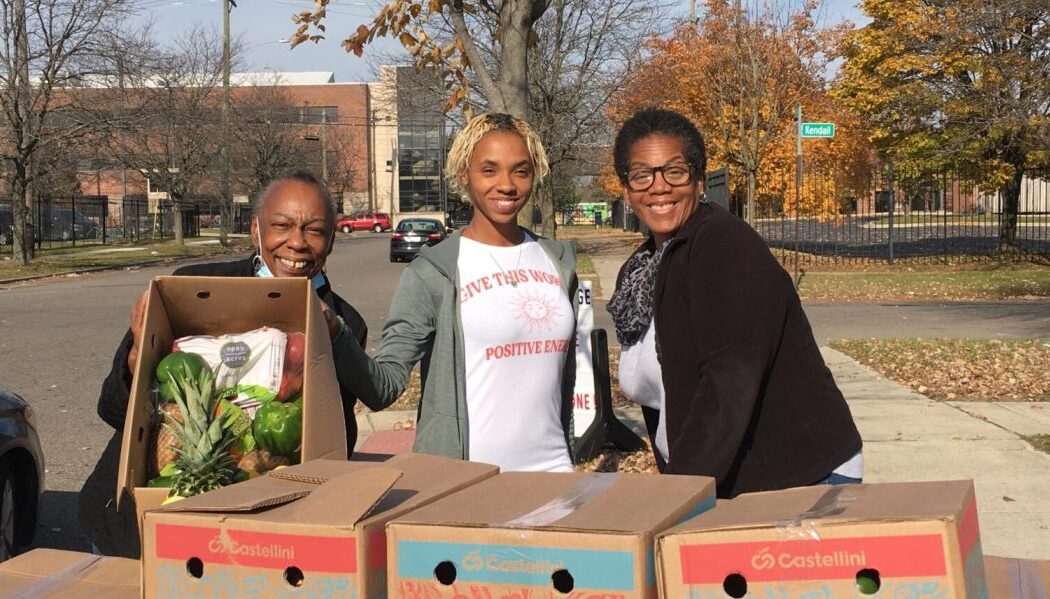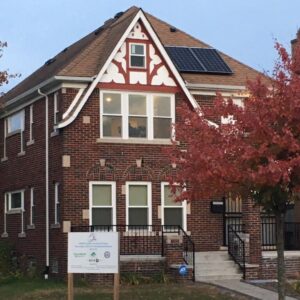On a tree-lined street in north central Detroit stands a brick two-family house renovated to the highest standards of energy efficiency from a state of burned-out disrepair.
Home to the HOPE Village Revitalization offices and neighborhood center, the house serves as a model of the type of transformation the community development corporation is bringing to the neighborhood.
Executive Director Debbie Fisher, who has been with HOPE Village Revitalization since its start in 2002, shares how the community-controlled organization works toward its vision of a sustainable, equitable, healthy neighborhood with a high quality of life for all.
Introduce us to HOPE Village Revitalization and the neighborhood you serve.
We work at the intersection of people and places, with three major focal points for achieving our goals.
One is fresh, local food access. We believe this is important to both a healthy community and to building entrepreneurship in the community. So we host a farmers market for 16 weeks of the year.
The second focal point is sustainable, affordable housing through energy efficiency.
We’ve worked with over 100 residents in the last three years to install high-efficiency furnaces, high-efficiency water heaters, insulation, infiltration reduction, and improvements like those.
We do minor home repairs through a Michigan State Housing Development Authority neighborhood enhancement program grant.
We are also working on opportunities for the neighborhood to move into the clean energy economy through solar on rooftops and moving toward electrification.
The third focal area is building a green and healthy community. We work on this area through a number of health initiatives. We have a walk-in wellness clinic and a community health advocate who connects adults and children to health resources. We also work to remove blight and advocate about neighborhood infrastructure issues.
Can you tell us about a project you worked on with the University of Michigan (U-M)?
Through the Ginsberg Center, Semester in Detroit, and the Undergraduate Research Opportunity Program, we’ve had wonderful students who have worked with us on probably seven different projects. Most recently, we had students help us put together our new webpage.
It speaks of our work in a really robust way. A couple of students have started to help us put together “neighborhood stories” talking to people in the neighborhood to understand how they got to where they are and what their plans are for the future.
We’ve seen a significant increase in our website traffic, and we’ve had people contact us through the website who didn’t know we existed before and want to volunteer and help with our mission in other ways.
Through Poverty Solutions, we’ve been working with a coalition to champion the Child Tax Credit and the Earned Income Tax Credit. We’ve had at least 30 neighborhood residents connect to resources through that effort.
One person who didn’t know she was eligible for the Child Tax Credit and couldn’t figure out how to navigate the process connected with our neighborhood resource navigator and applied for two years’ worth of credits she hadn’t received.
She got more than $17,000 for her family. She was ecstatic that she would be able to get her car fixed, and she had a long list of things she would be able to do that she wouldn’t have been able to do otherwise.
What have you found most valuable about your partnerships with U-M?
U-M brings a range of resources that we don’t otherwise have access to. It’s a big research university and there are lots of people working on different aspects of problems. We don’t have the bandwidth to do the research ourselves, so that’s helpful.
We’ve made connections with other entities and institutions through the Poverty Solutions Child Tax Credit project. We’ve had a wide range of committed, passionate, very intelligent U-M students who are willing to use their time and talents to help our neighborhood and our mission. That’s priceless.
What advice would you give to other organizations interested in partnering with the university?
U-M seems like it’s a multifaceted organization. There are so many different departments and centers, and you’re never going to know the full scope of what’s available.
Connecting with folks who are like-minded there – like Ray Wang from UROP, Craig Regester from Semester in Detroit, the Ginsberg Center, and the Graham Sustainability Institute with the Dow fellows – who can help you navigate the process and the different opportunities, that’s helpful.
You do have to invest time in the partnership. Meeting each week with the students who are helping us has been important.
Photos courtesy of Lauren Slagter. Featured photo shows the HOPE Village farmers market.
This article was written by Lauren Slagter and originally appeared on the University of Michigan website. Reprinted here by permission.


